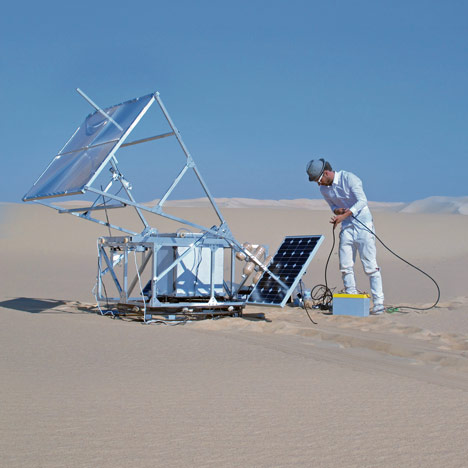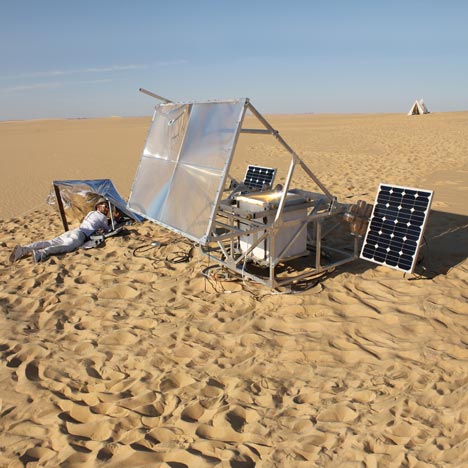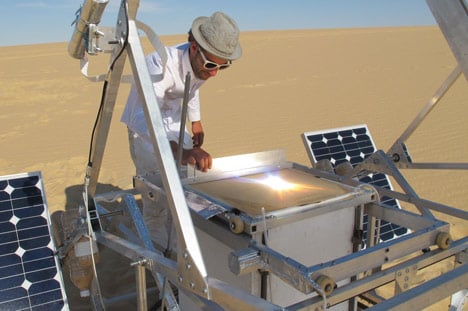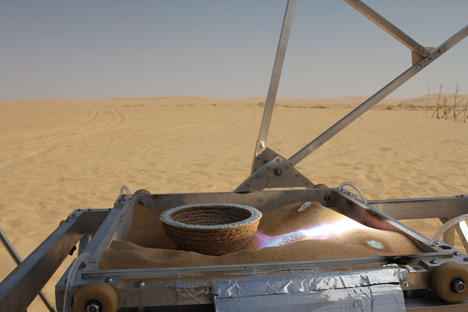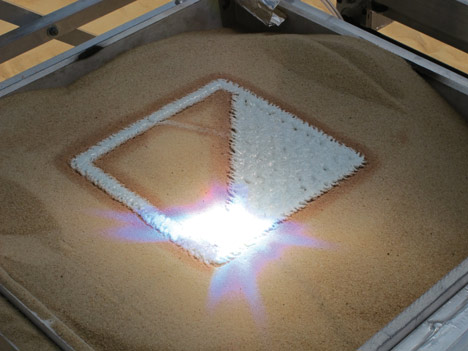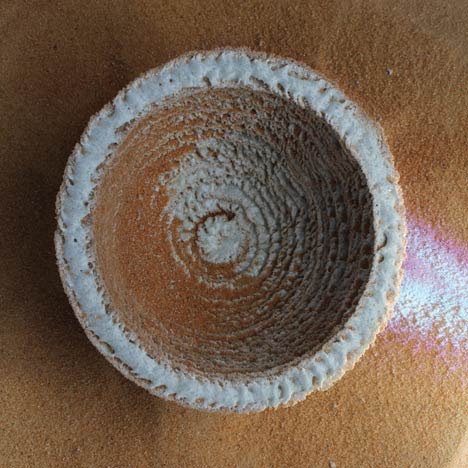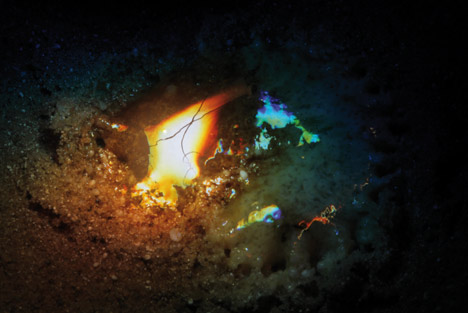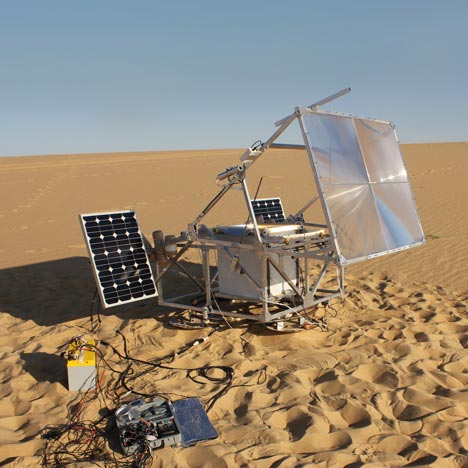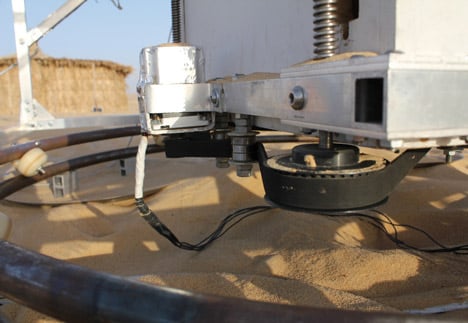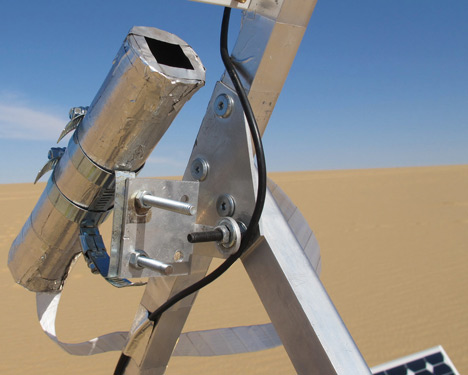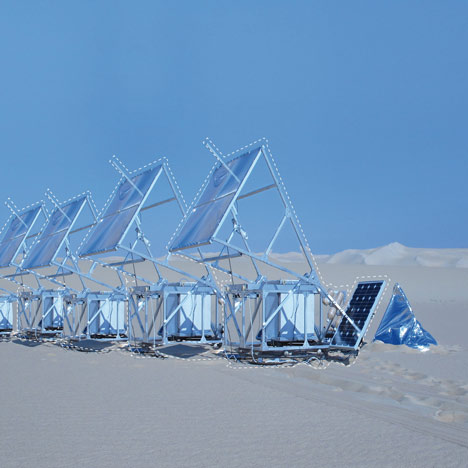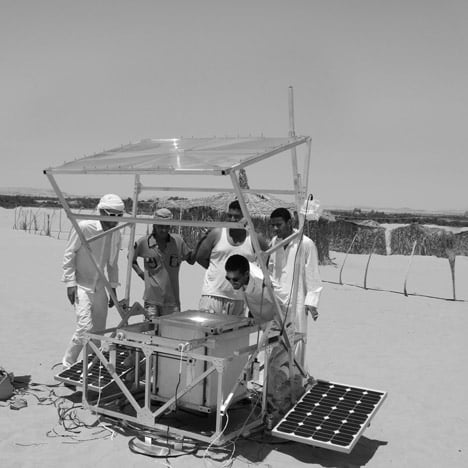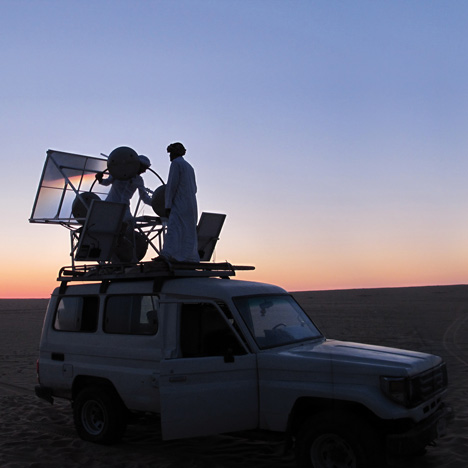یک تجربهی شورانگیز نسبتا خیلی اخیر که با تعلل های من این روزها در یانوندیزاین منتشر می شه.
پرینتری سه بعدی که تنها به مدد تمرکز نور خورشید در نقطهی کانونی عدسی هایی محدب اما خلاصه شده و با آب کردن شن صحرا و تولید سفال گونهای سخت و محکم ، احجام سه بعدی مجازی کامپیوتری رو عینیت می بخشه.
Called The Solar Sinter, the device uses a large Fresnel lens to focus a beam of sunlight, creating temperatures between 1400 and 1600 degrees Celsius.
This is hot enough to melt silica sand and build up glass shapes, layer by layer, inside a box of sand mounted under the lens.
Solar-powered motors move the box on an x and y axis along a computer-controlled path and a new layer of sand is sprinkled on top after each pass of the light beam.
Light sensors track the sun as it moves across the sky and the whole machine rotates on its base to ensure the lens is always producing the optimum level of heat.
Once all the layers have been melted into place the piece is allowed to cool and dug out from the sand box.
Kayser developed the project while studying on the MA Design Products course at the
Royal College of Art.
Here are some more details from Kayser:
In a world increasingly concerned with questions of energy production and raw material shortages, this project explores the potential of desert manufacturing, where energy and material occur in abundance. In this experiment sunlight and sand are used as raw energy and material to produce glass objects using a 3D printing process, that combines natural energy and material with high-tech production technology. Solar-sintering aims to raise questions about the future of manufacturing and triggers dreams of the full utilisation of the production potential of the world’s most efficient energy resource – the sun. Whilst not providing definitive answers, this experiment aims to provide a point of departure for fresh thinking.
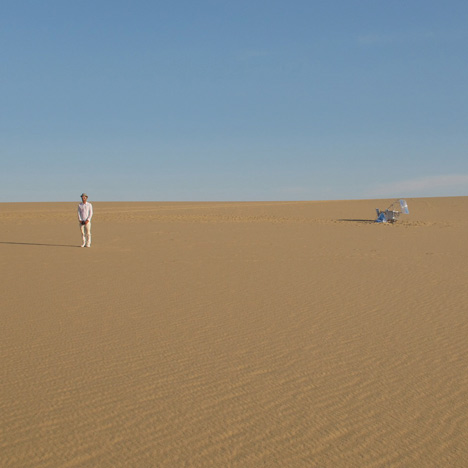
In the deserts of the world two elements dominate – sun and sand. The former offers a vast energy source of huge potential, the latter an almost unlimited supply of silica in the form of quartz. Silicia sand when heated to melting point and allowed to cool solidifies as glass. This process of converting a powdery substance via a heating process into a solid form is known as sintering and has in recent years become a central process in design prototyping known as 3D printing or SLS (selective laser sintering). These 3D printers use laser technology to create very precise 3D objects from a variety of powdered plastics, resins and metals – the objects being the exact physical counterparts of the computer-drawn 3D designs inputted by the designer. By using the sun’s rays instead of a laser and sand instead of resins, I had the basis of an entirely new solar-powered machine and production process for making glass objects that taps into the abundant supplies of sun and sand to be found in the deserts of the world.
My first manually operated solar-sintering machine was tested in February 2011 in the Moroccan desert with encouraging results that led to the development of the current larger and fully automated computer-driven version – the Solar-Sinter. The Solar-Sinter was completed in mid-May and later that month I took this experimental machine to the Sahara desert near Siwa, Egypt, for a two week testing period. The machine and the results of these first experiments presented here represent the initial significant steps towards what I envisage as a new solar-powered production tool of great potential.
The machine
The Solar-Sinter machine is based on the mechanical principles of a 3D printer.
A large Fresnel lens (1.4 x 1.0 metre) is positioned so that it faces the sun at all times via an electronic sun-tracking device, which moves the lens in vertical and horizontal direction and rotates the entire machine about its base throughout the day. The lens is positioned with its focal point directed at the centre of the machine and at the height of the top of the sand box where the objects will be built up layer by layer. Stepper motors drive two aluminium frames that move the sand box in the X and Y axes. Within the box is a platform that can move the vat of sand along the vertical Z axis, lowering the box a set amount at the end of each layer cycle to allow fresh sand to be loaded and levelled at the focal point.
Two photovoltaic panels provide electricity to charge a battery, which in turn drives the motors and electronics of the machine. The photovoltaic panels also act as a counterweight for the lens aided by additional weights made from bottles filled with sand.
3D printing process with sand and sunlight
The machine is run off an electronic board and can be controlled using a keypad and an LCD screen. Computer drawn models of the objects to be produced are inputted into the machine via an SD card. These files carry the code that directs the machine to move the sand box along the X, Y coordinates at a carefully calibrated speed, whilst the lens focuses a beam of light that produces temperatures between 1400°C and 1600°C, more than enough to melt the sand. Over a number of hours, layer by layer, an object is built within the confines of the sand box, only its uppermost layer visible at any one time. When the print is completed the object is allowed to cool before being dug out of the sand box. The objects have rough sandy reverse side whilst the top surface is hard glass. The exact colour of the resulting glass will depend on the composition of the sand, different deserts producing different results. By mixing sands, combinatory colours and material qualities may be achieved.
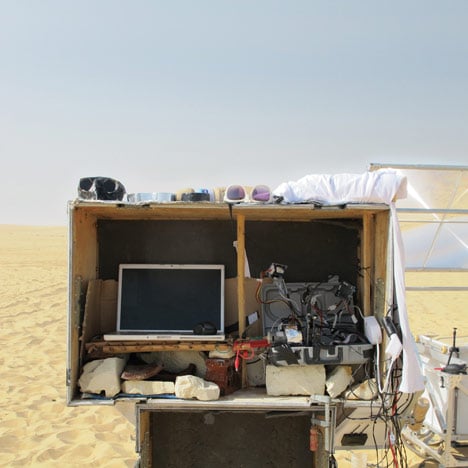
Machine and man
With the scenario of a single person’s utilisation of the machine in the desert, I play with ideas of how an individual could use the machine to produce objects.
In this first instance the creation of artefacts made by sunlight and sand is an act of pure experimentation and expression of ‘possibility’, but what of the future? I hope that the machine and the objects it created, stimulate debate about the vast potential of solar energy and naturally abundant materials like silica sand. These first experiments are simply an early manifestation of that potential.
Machine and community
In the context of a desert-based community, the Solar-Sinter machine could be used to create unique artefacts and functional objects, but also act as a catalyst for solar innovation for more prosaic and immediate needs. Further development could lead to additional solar machine processes such as solar welding, cutting, bending and smelting to build up a fully functioning solar workshop.
The vibrant and global ‘open-source’ community is already active in developing software and hardware for 3D printers and could play a key role in the rapid development of these technologies. The Solar-Sinter could simply be the starting point for a variety of further applications.
Machine and manufacture
In 1933, through the pages of ‘Modern Mechanix’ magazine, W.W. Beach was already imagining canals and “auto roads“ melted into the desert using sunlight focused through immense lenses. This fantastical large-scale approach is much closer to reality today, with ‘desert factories’ using sunlight as their power a tangible prospect. This image of a multiplicity of machines working in a natural cycle from dusk till Dawn presents a new idea of what manufacturing could be.
The objects could be anything from glass vessels to eventually the glass surfaces for photovoltaic panels that provide the factories power source… and, as Mr. Beach imagined 78 years ago, the water channels and glass roads that service them.
Dreaming of architecture
Printing directly onto the desert floor with multiple lenses melting the sand into walls, eventually building architecture in desert environments, could also be a real prospect. Experiments in 3D printing technologies are already reaching towards an architectural scale and it is not hard to imagine that, if partnered with the solar-sintering process demonstrated by the Solar-Sinter machine, this could indeed lead to a new desert-based architecture
